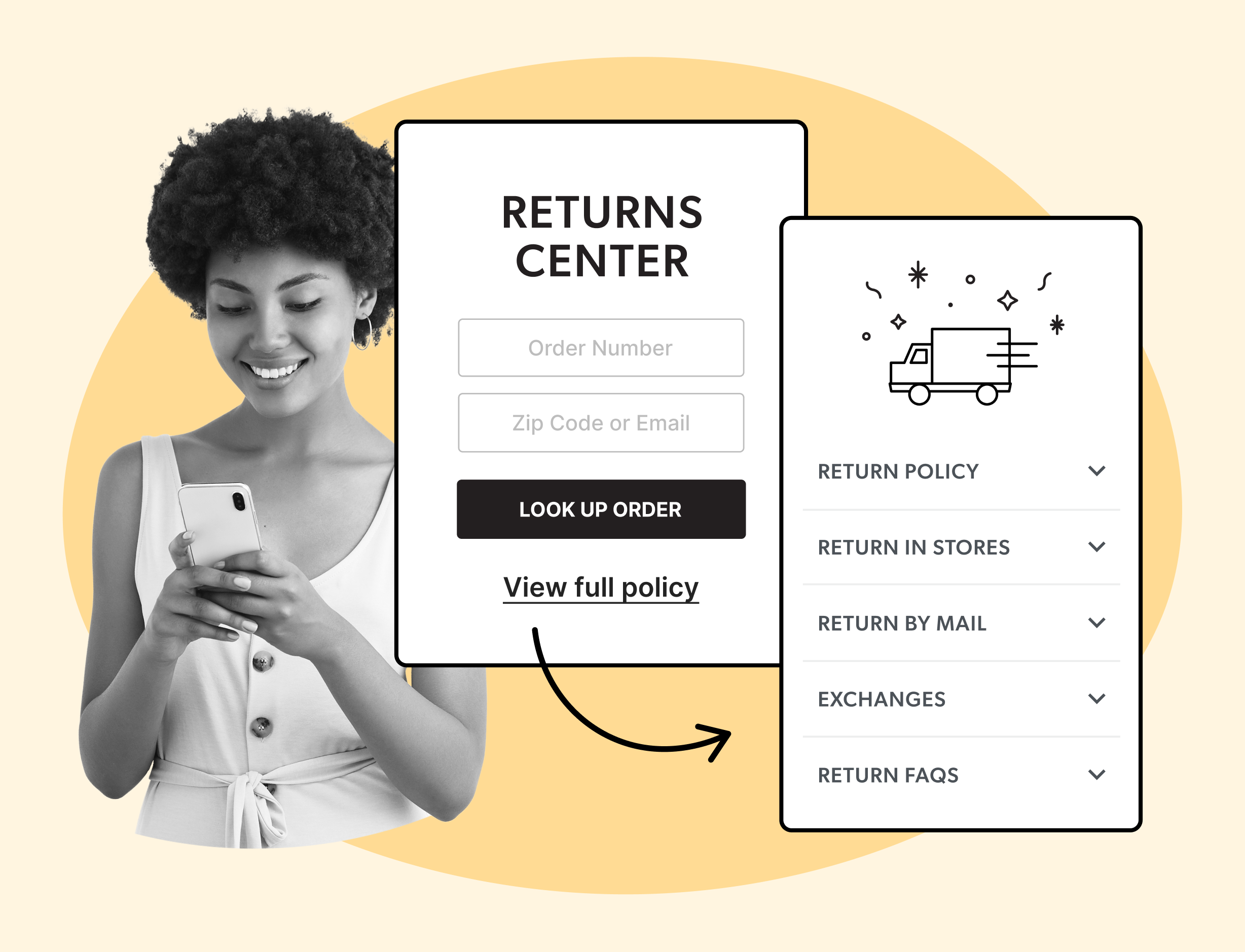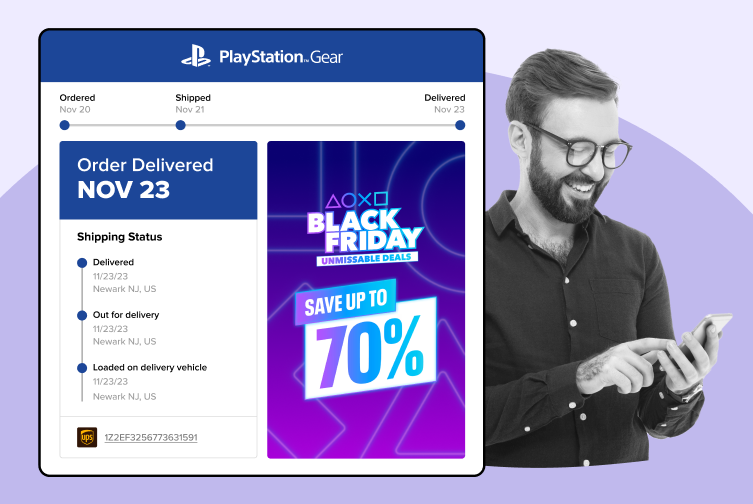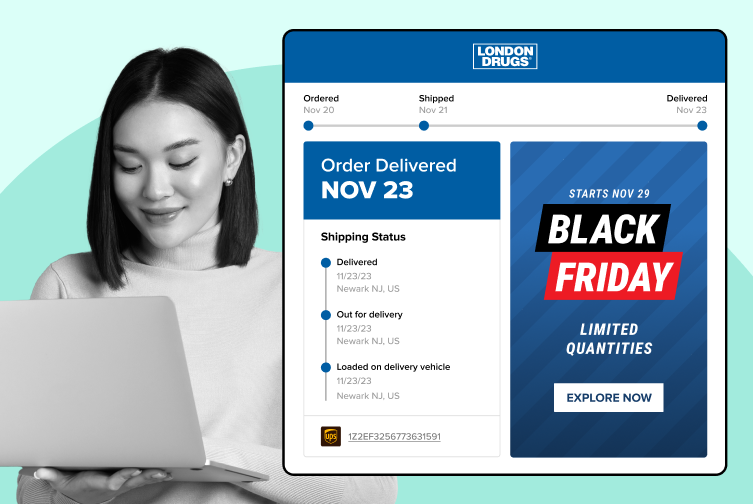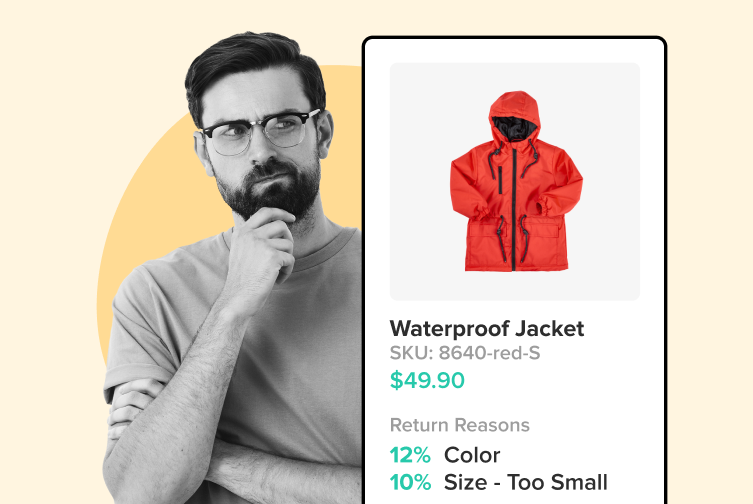
How to Design an Enterprise RMA Process for Ecommerce
Streamline your returns management with our guide to mastering the enterprise RMA process. Enhance efficiency and reduce hassle.
Shipping, Tracking & Notifications
Boost customer experience and reduce support tickets
Realtime order and shipment tracking
Proactive order and shipping notifications
AI-Enhanced Discounted Labels
Predictive pre-purchase estimated delivery dates
Self-Serivce branded order tracking
Effortless experience delivered
Identify and Resolve Order Issues
Realtime order and shipment tracking
Make returns profitable and delight customers
Flexibility to define any return destinations & conditions
Simplify returns for your customers and team
Incentivize exchanges over returns
Returns management made easy for your team
Returns management made easy for your team
Easy claims and smart upsells
Understand why your customers are returning
In-Store & Curbside Pickup
Unify the online and the in-store experience
Hassle-free pickup experience for customers
In-Store dashboard to keep operations streamlined
In-Store and Online orders unified
Drive foot-traffic to your stores
Shipping, Tracking & Notifications
Boost customer experience and reduce support tickets
Realtime order and shipment tracking
Proactive order and shipping notifications
AI-Enhanced Discounted Labels
Predictive pre-purchase estimated delivery dates
Self-Serivce branded order tracking
Effortless experience delivered
Identify and Resolve Order Issues
Realtime order and shipment tracking
Make returns profitable and delight customers
Flexibility to define any return destinations & conditions
Simplify returns for your customers and team
Incentivize exchanges over returns
Returns management made easy for your team
Returns management made easy for your team
Understand why your customers are returning
In-Store & Curbside Pickup
Unify the online and the in-store experience
Hassle-free pickup experience for customers
In-Store Dashboard to keep operations streamlined
In-Store and Online orders unified
Drive foot-traffic to your stores
Boost customer experience and reduce support tickets
Realtime order and shipment tracking
Proactive order and shipping notifications
AI-Enhanced Discounted Labels
Predictive pre-purchase estimated delivery dates
Self-Serivce branded order tracking
Effortless experience delivered
Make returns profitable and delight customers
Flexibility to define any return destinations & conditions
Simplify returns for your customers and team
Incentivize exchanges over returns
Returns management made easy for your team
Equip your team for precise return checks.
Easy claims and smart upsells
Understand why your customers are returning
Unify the online and the in-store experience
Hassle-free pickup experience for customers
In-Store Dashboard to keep operations streamlined
In-Store and Online orders unified
Drive foot-traffic to your stores
Find the answer to all your questions
Take a step by step trip through our functionality to see how we can improve your ecommerce processes.
Explore the most comon questions about WeSupply
Calculate the ROI that WeSupply can bring you
Read actionable articles on how to optimize your post-purchase experience and decrease support tickets
Get inspired by stories of how our customers implemented an effortless post-purchase experience
Wondering if WeSupply is a good fit for you? Read through our use cases to see how we can help you increase conversion & improve CX!
A Deep Dive into Top Companies' Order Tracking & Returns Strategy
Find the answer to all your questions
Explore the most comon questions about WeSupply
Calculate the ROI that WeSupply can bring you
Request a no strings attached review of your current shopping experience and missed conversion opportunities
Take a step by step trip through our functionality to see how we can improve your ecommerce processes.
Read actionable articles on how to optimize your post-purchase experience and decrease support tickets
Get inspired by stories of how our customers implemented an effortless post-purchase experience
A Deep Dive into Top Companies' Order Tracking & Returns Strategy
Wondering if WeSupply is a good fit for you? Read through our use cases to see how we can help you increase conversion & improve CX!

Returns are a fact of life in retail and ecommerce. Customers order items that don’t fit, products arrive damaged, or sometimes expectations don’t match reality. While returns can feel like a burden, they are also an opportunity. A clear, customer-friendly returns policy builds trust, improves loyalty, and sets your brand apart.
Nearly half of ecommerce shoppers check return policies before making a purchase, making it essential for retailers to offer a transparent and reassuring policy to capture potential sales.
For enterprise-level retailers, the stakes are even higher. You’re dealing with massive order volumes, global operations, and diverse customer expectations. Without a structured policy, returns can overwhelm operations and eat into profit margins. But with the right strategy, returns management can strengthen your brand while keeping costs under control. A clear returns policy can positively influence a customer’s purchase decision, especially when they cannot physically experience the product before buying.
This guide walks you through how to create an enterprise-level returns policy that works, from aligning with customer expectations to leveraging technology for automation.
Ecommerce returns are an unavoidable aspect of online shopping, shaping both customer satisfaction and the bottom line for any ecommerce business. As online shoppers cannot physically inspect products before purchasing, returns are more frequent than in brick and mortar stores. For ecommerce businesses, a well-structured return policy is not just a customer service tool it’s a strategic asset that helps manage returns efficiently, control shipping costs, and foster long-term customer loyalty.
The average ecommerce return rate is significantly higher than in physical retail, making it essential for businesses to have a clear plan in place. A thoughtful returns policy can turn a potentially negative experience into a positive one, encouraging repeat purchases and building trust. By prioritizing a smooth returns process, ecommerce businesses can reduce operational headaches, minimize unnecessary shipping costs, and ensure that customer satisfaction remains high even when things don’t go as planned.
Returns are no longer a back-office problem. They shape customer experience just as much as fast shipping and easy checkout.
High return rates: The National Retail Federation (NRF) reported that in 2023, 16.5% of all U.S. retail sales were returned, totaling $743 billion.
Ecommerce leads the way: Online sales see higher return rates, averaging 20-30%, compared to about 8-10% in physical stores.
Customer loyalty factor: A Klarna survey found that 84% of shoppers won’t buy again if the return process is difficult.
For enterprise retailers, these numbers translate into billions of dollars and millions of customer touchpoints. Handling returns effectively isn’t optional it’s central to success. High return volume creates significant operational challenges, making it crucial to manage reverse logistics costs and maintain customer loyalty.
A returns policy must meet customer expectations or it will drive shoppers away. Today’s customers expect:
Free or low-cost returns: A Narvar report shows 49% of shoppers check the return policy before buying. Free returns increase conversion rates, and many customers now expect returns to be free and hassle-free.
Flexible time windows: Many expect at least 30 days, with some brands offering up to 90.
Omnichannel options: Shoppers want to return online purchases in-store and vice versa, giving customers multiple convenient ways to initiate returns.
Transparency: No hidden fees or confusing rules.
The takeaway: Enterprise policies must balance cost control with customer convenience.
Ambiguity leads to disputes and delays. Be precise about what customers can expect by clearly outlining your store’s return policy.
Return windows: Common ranges are 30, 60, or 90 days. Clearly define the return window, which is typically calculated from the purchase date. Specify when the clock starts (purchase date, delivery date, or holiday extension).
Eligible products: Spell out exclusions (e.g., final-sale items, perishables, personalized goods).
Condition requirements: Items must be unworn, unopened, or returned in original packaging.
Refund vs. store credit: Clearly outline your refund policy and exchange policy. Decide whether refunds are standard or if store credit/exchanges are encouraged, and specify the terms for each.
Restocking fee: State if a restocking fee applies as part of your store’s return policy, and explain when and how it will be charged.
Enterprise-level retailers should keep policy language simple. If a customer can’t understand it in 30 seconds, it’s too complex.
A robust ecommerce return policy template is the foundation for any successful online store’s approach to returns, exchanges, and refunds. This template should clearly outline the return process, including specific return windows, available refund options, and any applicable restocking fees. By providing customers with a straightforward, hassle-free return process, online retailers can set clear expectations and reduce confusion.
Key elements of an effective ecommerce return policy template include offering free return shipping, detailing how and when refunds will be processed, and specifying the conditions under which returns are accepted. Including these details ensures that your return policy is easy to understand and consistent across all sales channels. For online retailers, using a standardized template not only streamlines internal operations but also reassures customers that your business model is built around transparency and customer care. Ultimately, a well-crafted ecommerce return policy template helps provide customers with a no-stress experience, encouraging future purchases and building brand loyalty.
Your policy should reflect your brand identity. For example:
Premium brands may limit return windows to preserve exclusivity.
Mass retailers often emphasize convenience with generous windows and free shipping.
Sustainable brands highlight eco-friendly practices, like encouraging exchanges over refunds.
An enterprise-level policy isn’t just about logistics it’s also a marketing tool. Patagonia, for example, emphasizes product longevity and repair before replacement, reinforcing its eco-conscious values. Aligning your returns policy with your brand values can significantly improve customer retention and serve as a strategy for building customer loyalty, making your policy a powerful marketing asset.
Large retailers must support multiple return channels:
In-store returns: Essential for omnichannel shoppers. Customers appreciate immediate refunds and zero shipping costs. Utilizing a brick and mortar store or physical store for returns enhances convenience and supports integrated shopping experiences. When customers return items in-store, they benefit from a seamless process and instant resolution.
Mail-in returns: Offer prepaid labels or QR codes, and provide at least one no cost option for returns to reduce purchase anxiety and encourage conversions.
Third-party drop-off points: Partnerships with UPS, FedEx, or lockers improve convenience.
Reverse logistics automation: Use technology to route returns to the nearest warehouse or resale channel.
Target and Walmart allow customers to return online orders at stores or through drop-off points. This flexibility reduces friction while driving foot traffic.
At scale, manual returns handling is impossible. Enterprise retailers must leverage technology.
Returns management platforms (RMS): Tools like WeSupply, Loop, or Narvar let customers start returns online, print labels, or get instant refunds. These platforms also help automate and streamline the reverse logistics process, making returns more efficient for both retailers and customers.
Automation: Automatically route returns to the nearest processing center and update inventory management systems in real time, reducing manual effort and errors in stock levels.
Data insights: Track return reasons, identify patterns, and act on product quality issues. Automation can also reduce the burden on the support team by addressing common return questions and minimizing manual intervention.
Fraud prevention: Systems detect wardrobing (returning used items) or tag-switching.
Retailers can also consider partnering with third party logistics providers to outsource returns management, further improving efficiency and scalability.
Streamline Returns with Automation & Insights
Book a quick call with our experts to see how WeSupply can help you simplify returns with automation, data-driven insights, and fraud prevention, giving your customers a seamless experience while cutting costs and improving operational efficiency.
The average ecommerce return rate is a critical metric for online retailers to monitor, as it directly impacts profitability and customer satisfaction. Recent studies indicate that the average ecommerce return rate hovers around 16.9%, though this figure can climb to 30% or higher in certain industries, such as fashion or electronics. Online shoppers often return items due to receiving the wrong item, issues with fit, or products arriving damaged factors that are less common in brick and mortar retail.
To address these challenges, ecommerce businesses should focus on meeting customer expectations by providing accurate product descriptions, high-quality images, and clear sizing information. Offering free returns and maintaining a hassle-free return policy can also help reduce the average ecommerce return rate, as customers feel more confident making online purchases. By understanding the reasons behind returns and proactively optimizing their return policy, online retailers can improve customer satisfaction, minimize unnecessary costs, and create a more efficient returns process that benefits both the business and its customers.
Generous policies can attract customers but also create risk. Enterprise brands must balance goodwill with financial responsibility.
Free returns vs. cost recovery: Some retailers, like Amazon, provide free returns for most items. Others, like Zara, now charge a small fee for online returns to discourage excessive ordering. Implementing return fees is a strategy to offset the costs of processing, shipping, and restocking returns.
Encouraging exchanges: Instead of refunds, offer incentives for exchanges or store credit. Giving customers the option to choose between store credit and cash refunds can help retain revenue and reduce the risk of return fraud.
Restocking fees: These can help offset costs but may frustrate customers if not clearly communicated.
An effective strategy is tiered generosity. For example, offer free returns for loyalty program members while charging a small fee for non-members. Clearly defining when and how you are accepting returns is essential to manage customer expectations and prevent abuse.
Return fraud costs U.S. retailers an estimated $101 billion annually (NRF). Common abuses include:
Wardrobing: Wearing items before returning them.
Receipt fraud: Using fake or duplicated receipts.
Tag-switching: Returning a cheaper item under a more expensive product’s label.
Solutions include:
Setting stricter rules for high-risk categories (like electronics or luxury items).
Using AI to flag suspicious return behavior.
Limiting return windows for certain products.
Refunding only to the original payment method to prevent fraud and ensure secure transactions.
Fraud prevention must be balanced with customer convenience. Overly strict rules risk alienating genuine shoppers.
Returns have a significant environmental impact. Returned goods generate 9.5 billion pounds of landfill waste annually in the U.S. alone. Customers are increasingly aware of this.
Ways to incorporate sustainability into your returns policy:
Encourage exchanges or repairs instead of refunds.
Use eco-friendly packaging for returns. Traditional prepackaged return labels often contribute to unnecessary waste; consider offering digital return labels to reduce paper usage.
Provide customers with the option to access or print a return label or return shipping label online, making the process more convenient and environmentally friendly.
Partner with recommerce platforms to resell returned items.
Highlight sustainable practices in your policy to attract eco-conscious shoppers.
For example, IKEA resells returned furniture through its “As-Is” program, reducing waste and appealing to budget-conscious shoppers.
A returns policy is not static. Review and optimize it regularly.
Track KPIs: Return rate, refund speed, exchange rate, and fraud cases.
Listen to feedback: Collect customer and employee input.
Benchmark competitors: Stay competitive with policy updates by comparing your returns policies and ecommerce return policies to those of leading brands.
Test changes: For example, see how extending return windows impacts loyalty.
Retailers like Nordstrom have updated their famous “no-questions-asked” policy over time to balance generosity with abuse prevention. Continuous improvement is key to long-term success. Online merchants should regularly review and refine their returns policies to ensure they meet evolving customer expectations and industry standards.
Creating a returns policy for enterprise ecommerce doesn’t have to be confusing. With WeSupply, you can set up clear rules, automate processes, and give your customers the easy return experience they expect. Here’s how:
Track customer happiness (CSAT, NPS, CES) – Measure how satisfied customers are, how loyal they feel, and how easy their experience is. This helps you spot problems fast and fix them.
Analyze return trends with data – Identify top-returned products, frequent returners, and fraud risks. Use insights to reduce returns and improve operations.
Turn refunds into exchanges or store credit – Encourage repeat shopping by offering exchanges, gift cards, or store credit instead of refunds.
WeSupply makes enterprise returns policies clear, flexible, and efficient. You get automation and insights, while your customers enjoy a hassle-free return experience that keeps them coming back.
👉 Ready to see how it works? Book a demo with WeSupply today and start building a returns policy that works for your business.
Creating an enterprise-level returns policy means combining flexibility, automation, and customer trust.
With WeSupply, you can build custom return rules by region, product type, or reason, clearly define non-returnable items, and manage return windows without confusion. Control where returns go, whether warehouses, 3PLs, or stores, while offering in-store, curbside, and printerless QR code returns. Enable green returns or keep-the-item options to reduce waste and cost. Automate return labels across 100+ carriers, split shipments to cut logistics costs, and protect fragile items. Use returns analytics to identify problem products, track serial returners, and prevent fraud.
Automate processes to save 80% of return handling time while converting refunds into exchanges or store credit. Done right, your returns policy becomes a strategic advantage building loyalty, reducing costs, and keeping customers coming back.
Returns Analytics for eCommerce Business
Book a quick call with our experts to see how WeSupply can help you understand why your customers are returning: Identify the most returned products, Understand why those products are returned, Identify which customers are serial returners, Reduce Return Rate with Actionable Insights, Returns data available in BigQuery.
1. How can businesses reduce shipping costs without hurting customer service?
Businesses can cut shipping costs by right-sizing packaging, comparing carriers, optimizing delivery routes, and using technology for automation and tracking while maintaining fast, reliable delivery.
2. What is the most effective way to lower packaging costs?
Right-size boxes, use lightweight materials, adopt cartonization software, and leverage free carrier packaging. These steps reduce DIM weight charges and material expenses.
3. Why is supply chain management important for reducing shipping costs?
Placing inventory closer to customers, using multiple fulfillment centers, and adopting just-in-time strategies reduce transportation zones, lower costs, and improve delivery speed.
4. How does WeSupply automate returns management?
WeSupply automates workflows, instantly generates return labels across 100+ carriers, and routes products to the correct warehouse, 3PL, or donation center, saving up to 80% of return handling time.
5. Can customers make printerless returns with WeSupply?
Yes. WeSupply offers QR code returns at FedEx, USPS, and Walgreens locations, letting customers return items without printing labels. This makes returns faster and more convenient.
6. How does WeSupply help reduce return fraud?
WeSupply tracks return patterns, identifies serial returners, and flags high-risk transactions. Retailers gain visibility into fraud risks while still keeping the customer experience simple and seamless.
7. Does WeSupply have an Official Shopify App?
Yes. WeSupply has an Official Shopify App. You can download it and start integrating with your Shopify Store.
8. Does WeSupply have an official Magento extension?
Yes, WeSupply has an official extension for Magento. The WeSupply x Magento integration allows for automating order tracking experiences, reducing customer inquiries, automating shipping email and SMS notifications, and providing a fully branded order tracking experience.
9. Does WeSupply have an official BigCommerce App?
Yes, WeSupply has an official BigCommerce App. You can integrate WeSupply with your BigCommerce store to improve your post-purchase customer experience.
Learn How To Create Successful Post Purchase Email Campaigns
Build an effective post-purchase email flow that helps you increase customer satisfaction and drive revenue growth!
Negotiate better terms with suppliers. Partnering with reliable suppliers and carriers creates leverage in negotiations. For example, committing to steady shipping volume can lead to lower rates or priority service by securing discounts based on quantities shipped.

Streamline your returns management with our guide to mastering the enterprise RMA process. Enhance efficiency and reduce hassle.

Discover effective strategies for managing returns in retail. Enhance customer satisfaction while minimizing costs. Read the article for practical insights.

Learn effective strategies for handling shipping exceptions and keeping customers informed. Enhance your shipping process today!

Discover practical strategies to reduce shipping costs for your business. Boost your bottom line without sacrificing service. Read the article now!

Boost your average order value with effective upselling strategies post-purchase. Discover practical tips to enhance customer satisfaction. Read more!

Discover effective strategies to enhance ecommerce revenue retention and foster customer loyalty. Read the article to elevate your business success.

Discover how to analyze returns data to reduce return rates and boost profitability. Learn effective strategies to enhance your business’s performance.

Discover effective methods for analyzing customer feedback post-purchase. Enhance satisfaction and drive improvement!

Learn effective strategies to combat wardrobing and tag switching in fashion ecommerce. Protect your business and enhance customer trust. Read more now!